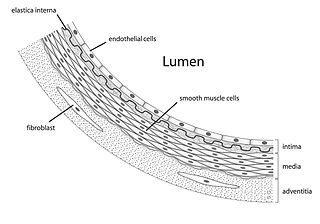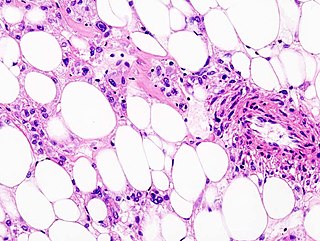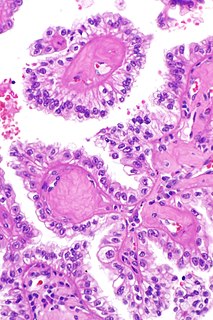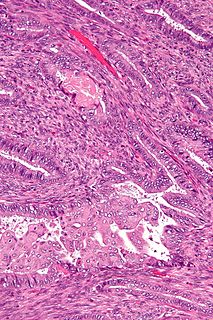Related Research Articles

The peripheral nervous system (PNS) is one of two components that make up the nervous system of bilateral animals, with the other part being the central nervous system (CNS). The PNS consists of the nerves and ganglia outside the brain and spinal cord. The main function of the PNS is to connect the CNS to the limbs and organs, essentially serving as a relay between the brain and spinal cord and the rest of the body. Unlike the CNS, the PNS is not protected by the vertebral column and skull, or by the blood–brain barrier, which leaves it exposed to toxins and mechanical injuries.

Smooth muscle is an involuntary non-striated muscle. It is divided into two subgroups; the single-unit (unitary) and multiunit smooth muscle. Within single-unit cells, the whole bundle or sheet contracts as a syncytium.

Vascular smooth muscle refers to the particular type of smooth muscle found within, and composing the majority of the wall of blood vessels.

Muscle contraction is the activation of tension-generating sites within muscle fibers. In physiology, muscle contraction does not necessarily mean muscle shortening because muscle tension can be produced without changes in muscle length, such as when holding a heavy book or a dumbbell at the same position. The termination of muscle contraction is followed by muscle relaxation, which is a return of the muscle fibers to their low tension-generating state.

The myometrium is the middle layer of the uterine wall, consisting mainly of uterine smooth muscle cells but also of supporting stromal and vascular tissue. Its main function is to induce uterine contractions.
Vasomotor refers to actions upon a blood vessel which alter its diameter. More specifically, it can refer to vasodilator action and vasoconstrictor action.
The interstitial cell of Cajal (ICC) is a type of interstitial cell found in the gastrointestinal tract. There are different types with different functions. Myenteric Interstitial cells of Cajal (ICC-MY) serve as a pacemaker which creates the bioelectrical slow wave potential that leads to contraction of the smooth muscle.

Angiomyolipomas are the most common benign tumour of the kidney. Although regarded as benign, angiomyolipomas may grow such that kidney function is impaired or the blood vessels may dilate and burst, leading to bleeding.
Somatostatinomas are a tumor of the delta cells of the endocrine pancreas that produces somatostatin. Increased levels of somatostatin inhibit pancreatic hormones and gastrointestinal hormones. Thus somatostatinomas are associated with mild diabetes mellitus, steatorrhoea and gallstones, and achlorhydria. Somatostatinomas are commonly found in head of pancreas. Only ten percent of somatostatinomas are functional tumours [9], and 60-70% of tumours are malignant. Nearly two thirds of patients with malignant somatostatinomas will present with metastatic disease.

A myofibroblast is a cell that is in between a fibroblast and a smooth muscle cell in phenotype.

The submucosa is a thin layer of tissue in various organs of the gastrointestinal, respiratory, and genitourinary tracts. It is the layer of dense irregular connective tissue that supports the mucosa and joins it to the muscular layer, the bulk of overlying smooth muscle.

Muscle tissue is a soft tissue that composes muscles in animal bodies, and gives rise to muscles' ability to contract. This is opposed to other components or tissues in muscle such as tendons or perimysium. It is formed during embryonic development through a process known as myogenesis. Muscle tissue consists of elongated cells also called as muscle fibers. This tissue is responsible for movements in our body. Muscles contain special proteins called contractile protein which contract and relax to cause movement.

Perivascular epithelioid cell tumour, also known as PEComa or PEC tumour, is a family of mesenchymal tumours consisting of perivascular epithelioid cells (PECs). These are rare tumours that can occur in any part of the human body.

Endothelin 2 (ET-2) is a protein encoded by the EDN2 gene in humans. It was first discovered in 1988 by Yanagisawa and team and belongs to a family of three endothelin peptide isoforms, which constrict blood vessels. ET-2 is encoded by genes on separate chromosomes to its isoforms and is mainly produced in vascular endothelial cells of the kidney, placenta, uterus, heart, central nervous system and intestine. It becomes present in the blood of animals and humans at levels ranging from 0.3pg/ml to 3pg/ml. ET-2 acts by binding to two different G-protein coupled receptors (GCPRs), the endothelin A receptor (EDNRA) and the endothelin B receptor (EDNRB).
'Smooth muscle tumor of uncertain malignant potential, abbreviated STUMP, is an uncommon tumor of the uterine smooth muscle that may behave like a benign tumor or a cancerous tumor.

Reed’s syndrome is a rare inherited condition characterised by multiple cutaneous leiomyomas and, in women, uterine leiomyomas. It predisposes for renal cell cancer, an association denominated hereditary leiomyomatosis and renal cell cancer, and it is also associated with increased risk of uterine leiomyosarcoma. The syndrome is caused by a mutation in the fumarate hydratase gene, which leads to an accumulation of fumarate. The inheritance pattern is autosomal dominant.

Atypical polypoid adenomyoma (APA) is a rare uncommon benign tumour of the uterus.

The gastrointestinal wall of the gastrointestinal tract is made up of four layers of specialised tissue. From the inner cavity of the gut outwards, these are:
STUMP may refer to:
A bronchial leiomyoma is a relatively rare form of lung tumours. These tumours can form in the lower respiratory tract tissue of the bronchi, trachea and other lung tissue. They may also be derived from blood vessels. These tumors typically form from the smooth muscle tissue lining the bronchi. They grow as a solitary tumor attaching themselves to the sides of the bronchi.
References
- ↑ Rosai and Ackerman's Surgical Pathology (11 ed.). Elsevier. 2018. pp. 502–527.
| This medical sign article is a stub. You can help Wikipedia by expanding it. |